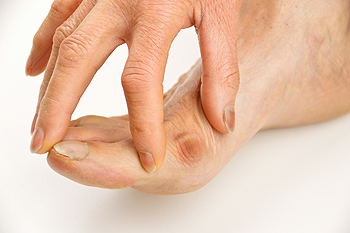 A tailor’s bunion, also known as a bunionette, is similar to a regular bunion. However, a tailor’s bunion forms on the fifth metatarsal bone at the base of the little toe, also known as the pinky toe, as opposed to the big toe. In some cases, tailor’s bunions can be caused by an inherited mechanical structure that results in the enlargement of the bone and causes the bone to move outward while the toe moves inward. In other cases, bone spurs that form on the toe can also appear as a tailor’s bunion. Shoes that are too narrow in the toe can not only lead to new tailor’s bunions, but they can aggravate existing ones as well. If you are dealing with pain from a tailor’s bunion, it is important to consult with a podiatrist for a proper diagnosis and treatment plan.
A tailor’s bunion, also known as a bunionette, is similar to a regular bunion. However, a tailor’s bunion forms on the fifth metatarsal bone at the base of the little toe, also known as the pinky toe, as opposed to the big toe. In some cases, tailor’s bunions can be caused by an inherited mechanical structure that results in the enlargement of the bone and causes the bone to move outward while the toe moves inward. In other cases, bone spurs that form on the toe can also appear as a tailor’s bunion. Shoes that are too narrow in the toe can not only lead to new tailor’s bunions, but they can aggravate existing ones as well. If you are dealing with pain from a tailor’s bunion, it is important to consult with a podiatrist for a proper diagnosis and treatment plan.
If you are suffering from bunions, contact Dr. Lubrina Bryant of District Podiatry, PLLC. Our doctor can provide the care you need to keep you pain-free and on your feet.
What Is a Bunion?
A bunion is formed of swollen tissue or an enlargement of boney growth, usually located at the base joint of the toe that connects to the foot. The swelling occurs due to the bones in the big toe shifting inward, which impacts the other toes of the foot. This causes the area around the base of the big toe to become inflamed and painful.
Why Do Bunions Form?
Genetics – Susceptibility to bunions are often hereditary
Stress on the feet – Poorly fitted and uncomfortable footwear that places stress on feet, such as heels, can worsen existing bunions
How Are Bunions Diagnosed?
Doctors often perform two tests – blood tests and x-rays – when trying to diagnose bunions, especially in the early stages of development. Blood tests help determine if the foot pain is being caused by something else, such as arthritis, while x-rays provide a clear picture of your bone structure to your doctor.
How Are Bunions Treated?
If you have any questions, please feel free to contact our office located in Washington, D.C . We offer the newest diagnostic and treatment technologies for all your foot care needs.